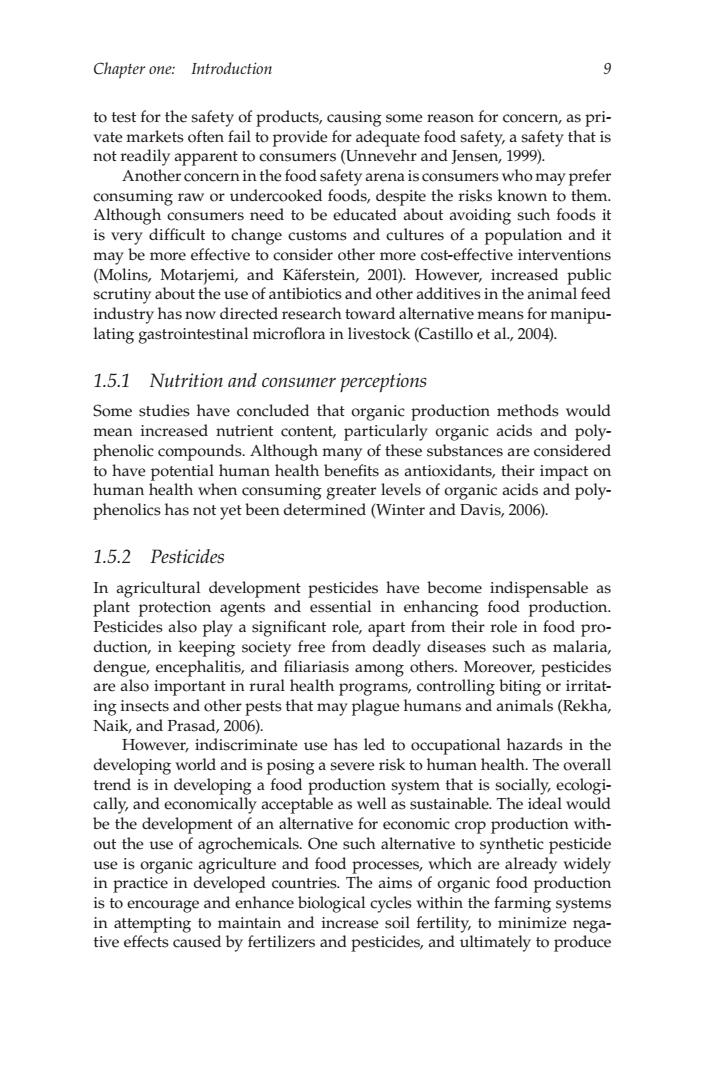正在加载图片...

Chapter one:Introduction 9 to test for the safety of products,causing some reason for concern,as pri- vate markets often fail to provide for adequate food safety,a safety that is not readily apparent to consumers(Unnevehr and Jensen,1999). Another concern in the food safety arena is consumers who may prefer cons ing raw or under cooked foods ite the risks known to Althoug consumers need to be educated about avoiding such foods is very difficult to change customs and cultures of a population and it may be more effective to consider other more cost-effective interventions (Molins,Motariemi,and Kaferstein,2001).However,increased public scrutiny about the use of antibiotics and other additives in the animal feed industry has now directed res earch toward alte manipu lating gastrointestinal microflora in livestock(Castillo et al,2004). 1.5.1 Nutrition and consumer perceptions Some studies have concluded that organic production methods would mean increasedo th su phenolic compour to have potential human health benefits as antioxidants,their impact on human health when consuming greater levels of organic acids and poly- phenolics has not yet been determined(Winter and Davis,2006). 1.5.2 Pesticides In agricultural development pesticides have become indispensable as plant protection agents and essential in enhancing food production. Pesticides also play a significant role,apart from their role in food pro- duction,in keeping society free from deadly diseases such as malaria, and filiariasis among others.More nt in rural health program er,pesticides controlling bit ing or irrita ing insects and other pests that may plague humans and animals(Rekha, Naik.and Prasad.2006). However,indiscriminate use has led to occupational hazards in the developing world and is posing a severe risk to human health.The overall trend is in deve a food oduction cally,and economic acceptab I w be the development of an alternative for economic crop production with out the use of agrochemicals.One such alternative to synthetic pesticide use is organic agriculture and food processes,which are already widely npractice in developed countries.The aims of organic food production encourage and enhance biological cycles within the farn ing systems in attempting to naintain and increase il fertility,to minimize nega- tive effects caused by fertilizers and pesticides,and ultimately to produce Chapter one: Introduction 9 to test for the safety of products, causing some reason for concern, as private markets often fail to provide for adequate food safety, a safety that is not readily apparent to consumers (Unnevehr and Jensen, 1999). Another concern in the food safety arena is consumers who may prefer consuming raw or undercooked foods, despite the risks known to them. Although consumers need to be educated about avoiding such foods it is very difficult to change customs and cultures of a population and it may be more effective to consider other more cost-effective interventions (Molins, Motarjemi, and Käferstein, 2001). However, increased public scrutiny about the use of antibiotics and other additives in the animal feed industry has now directed research toward alternative means for manipulating gastrointestinal microflora in livestock (Castillo et al., 2004). 1.5.1 Nutrition and consumer perceptions Some studies have concluded that organic production methods would mean increased nutrient content, particularly organic acids and polyphenolic compounds. Although many of these substances are considered to have potential human health benefits as antioxidants, their impact on human health when consuming greater levels of organic acids and polyphenolics has not yet been determined (Winter and Davis, 2006). 1.5.2 Pesticides In agricultural development pesticides have become indispensable as plant protection agents and essential in enhancing food production. Pesticides also play a significant role, apart from their role in food production, in keeping society free from deadly diseases such as malaria, dengue, encephalitis, and filiariasis among others. Moreover, pesticides are also important in rural health programs, controlling biting or irritating insects and other pests that may plague humans and animals (Rekha, Naik, and Prasad, 2006). However, indiscriminate use has led to occupational hazards in the developing world and is posing a severe risk to human health. The overall trend is in developing a food production system that is socially, ecologically, and economically acceptable as well as sustainable. The ideal would be the development of an alternative for economic crop production without the use of agrochemicals. One such alternative to synthetic pesticide use is organic agriculture and food processes, which are already widely in practice in developed countries. The aims of organic food production is to encourage and enhance biological cycles within the farming systems in attempting to maintain and increase soil fertility, to minimize negative effects caused by fertilizers and pesticides, and ultimately to produce